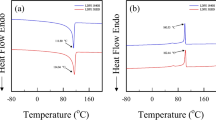Abstract
Rubber-like materials are widely used in several industrial applications. In these applications, rubber components are largely subjected to biaxial loading at a range of temperatures. In this work, we study the effect of short-term temperature on the ultimate properties of rubber materials, particularly, their strength. Such studies are lacking in the literature. For this purpose, we consider three different rubber-like materials; Nitrile Butadiene Rubber (NBR), Neoprene and Silicone. These rubber materials are tested under equi-biaxial tension using the bulge test. Tests are conducted till failure under a constant temperature. Four different temperatures are considered; 25 ∘C, 50 ∘C, 70 ∘C and 90 ∘C. Experiments are modeled using a finite element method. A constitutive model which includes the description of failure through energy limiters is calibrated against the bulge experiments. It is found that while the material stiffness is not significantly affected by temperature the ultimate stress and stretch, as well as the energy limiter for NBR and Neoprene greatly depend upon temperature. Stress carrying capacity for NBR and Neoprene decreases drastically at the highest temperature considered as compared to their values at room temperature (25 ∘C). Properties of Silicone are not affected significantly because of its temperature resistance. A new constitutive function is developed for the energy limiter, which allows unifying the description of different materials.















Similar content being viewed by others
References
Epps JA (1994) Uses of recycled rubber tires in highways, vol 198. Transportation Research Board
Saccomandi G, Ogden R W (2004) Mechanics and thermomechanics of rubberlike solids, vol 452. Springer, Berlin
Anthony R L, Caston R H, Guth E (1942) Equations of state for natural and synthetic rubber-like materials. I. Unaccelerated natural soft rubber. J Phys Chem 46(8):826–840
Li X, Bai T, Li Z, Liu L (2016) Influence of the temperature on the hyper-elastic mechanical behavior of carbon black filled natural rubbers. Mech Mater 95:136–145
Lion A (1997) On the large deformation behaviour of reinforced rubber at different temperatures. J Mech Phys Solids 45(11):1805–1834
Rey T, Chagnon G, Le Cam J B, Favier D (2013) Influence of the temperature on the mechanical behaviour of filled and unfilled silicone rubbers. Polym Test 32(3):492–501
Treloar L R G (1975) The physics of rubber elasticity. Oxford University Press, Oxford
Gent A, Lindley P (1959) Internal rupture of bonded rubber cylinders in tension. Proc R Soc Lond A: Math Phys Eng Sci The Royal Society 249:195–205
Hamdi A, Abdelaziz M N, Hocine N A, Heuillet P, Benseddiq N (2006) A fracture criterion of rubber-like materials under plane stress conditions. Polym Test 25(8):994–1005
Marckmann G, Verron E (2006) Comparison of hyperelastic models for rubber-like materials. Rubber Chem Technol 79(5):835–858
Dickie R A, Smith T L (1969) Ultimate tensile properties of elastomers. VI. Strength and extensibility of a styrene–butadiene rubber vulcanizate in equal biaxial tension. J Polym Sci B Polym Phys 7(4):687–707
Charalambides M N, Wanigasooriya L, Williams G J, Chakrabarti S (2002) Biaxial deformation of dough using the bubble inflation technique. I. Experimental. Rheol Acta 41(6):532– 540
Fried I (1982) Finite element computation of large rubber membrane deformations. Int J Numer Methods Eng 18(5):653–660
Sasso M, Palmieri G, Chiappini G, Amodio D (2008) Characterization of hyperelastic rubber-like materials by biaxial and uniaxial stretching tests based on optical methods. Polym Test 27(8):995–1004
Coran A, Patel R (1980) Rubber-thermoplastic compositions. Part II. nbr-nylon thermoplastic elastomeric compositions. Rubber Chem Technol 53(4):781–794
Roeder C W, Stanton J F (1983) Elastomeric bearings: state-of-the-art. J Struct Eng 109(12):2853–2871
Rodgers B (2015) Rubber compounding: chemistry and applications, 2nd edn. CRC Press, Boca Raton
Volokh K (2007) Hyperelasticity with softening for modeling materials failure. J Mech Phys Solids 55 (10):2237–2264
Volokh K (2010) On modeling failure of rubber-like materials. Mech Res Commun 37(8):684–689
Volokh K (2013) An approach to elastoplasticity at large deformations. Eur J Mech A Solids 39:153–162
Volokh K (2013) Review of the energy limiters approach to modeling failure of rubber. Rubber Chem Technol 86(3):470–487
Yeoh O (1990) Characterization of elastic properties of carbon-black-filled rubber vulcanizates. Rubber Chem Technol 63(5):792–805
Acknowledgments
The support from the Israel Science Foundation (ISF-198/15) and the Israel Ministry of Construction is gratefully acknowledged. Authors also acknowledge help from Ofir Barak in preparing the LabVIEW interface for the experimental setup.
Author information
Authors and Affiliations
Corresponding author
Rights and permissions
About this article
Cite this article
Lev, Y., Faye, A. & Volokh, K.Y. Experimental Study of the Effect of Temperature on Strength and Extensibility of Rubberlike Materials. Exp Mech 58, 847–858 (2018). https://doi.org/10.1007/s11340-018-0374-7
Received:
Accepted:
Published:
Issue Date:
DOI: https://doi.org/10.1007/s11340-018-0374-7




